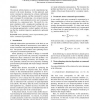Free Online Productivity Tools
i2Speak
i2Symbol
i2OCR
iTex2Img
iWeb2Print
iWeb2Shot
i2Type
iPdf2Split
iPdf2Merge
i2Bopomofo
i2Arabic
i2Style
i2Image
i2PDF
iLatex2Rtf
Sci2ools
73
Voted
IJON
2007
2007
Motor planning and sparse motor command representation
The present article proposes a novel computational approach to the motor planning. In this approach, each motor command is represented as a linear combination of prefixed basis patterns, and the command for a given task is designed by minimizing a two-termed criterion consisting of a task optimization term and a parameter preference (i.e., sparseness) term. The result of a computer simulation with a single-joint reaching task confirmed that our “representation-based” criterion for motor planning appropriately worked, together with showing that the resultant trajectory qualitatively replicated Fitts’ law.
Related Content
| Added | 15 Dec 2010 |
| Updated | 15 Dec 2010 |
| Type | Journal |
| Year | 2007 |
| Where | IJON |
| Authors | Yutaka Sakaguchi, Shiro Ikeda |
Comments (0)

